by Marjorie Moore | Nov 25, 2016
I don’t know about you but to me it seems we just finished shopping for the holidays and they are here once again. Holiday shopping can be a whirlwind and we forget to take time to stop and think about how much we have spent until the bills arrive. Having a budget for the holidays can be your best defense to not overdoing it this holiday season.
If you plan for the holidays, it can save lots of time, energy, and of course, money. It is important to prepare a budget, make the budget realistic and base it on your cash flow and financial obligations. Once your budget has been created, stick to it!
The next step – make a list of gifts you want to give. When shopping, use cash whenever you can as this helps you watch how much you are spending. When you have reached your budget limit, your shopping should be done! If possible, do not use credit cards to buy gifts. If you use credit cards, keep track of the amounts and stop when you have reached your budget limit.
Gift cards appear to be great but be aware of fees or usage terms that can reduce the value of the gift. Before buying gift cards, ask if the card can be used for online purchases. This may not affect most retailers but some online retailers do not allow using gift cards.
If you want to stretch your budget, you don’t have to purchase all of your gifts. Try making gifts such as food or give a coupon book volunteering your services (i.e. babysitting or yard work). Below is a mix ranch dressing recipe you can give to family and friends this holiday season.
To help with your shopping next year make your list early, then spread your shopping throughout the year.
Use these tips to help you enjoy your holiday.
Spoonful Mix for Ranch Dressing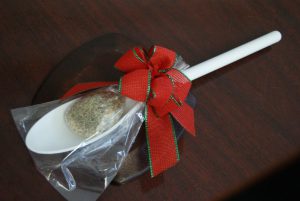
2 tsp. dried parsley flakes
1 tsp. salt free herb seasoning blend
½ tsp. garlic powder
¼ tsp. dried basil leaves
- Mix all ingredients in small bowl.
- Place mix in to plastic wrap and attach to spoon.
- Decorate spoon with a pretty bow.
Ranch Dressing
Remove decorative wrappings from spoon, leaving the mix inside the plastic wrap and still attached to spoon.
- Empty ½ cup low-fat mayonnaise and ½ cup low-fat buttermilk into a medium bowl.
- Hold spoon over bowl and cut open bag of mix, allowing mix to fall into bowl onto mayo and buttermilk.
- Mix until very well blended (use gift spoon to mix). Refrigerate 30 minutes up to 8 hours to blend flavors.
For more information on holiday shopping, contact your local Extension office.
by Marjorie Moore | Jun 1, 2016
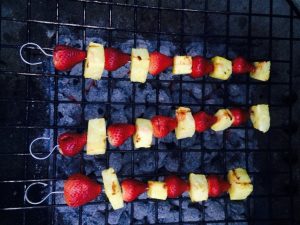 Did you know that the majority of people grill on July 4th (82%), followed by Birthdays (72%), Labor Day (70%), Memorial Day (62%) and the Super Bowl (30%)? Grilling is an all-time favorite for many households and now that the weather is warming, more families are using their grills to prepare family meals.
Did you know that the majority of people grill on July 4th (82%), followed by Birthdays (72%), Labor Day (70%), Memorial Day (62%) and the Super Bowl (30%)? Grilling is an all-time favorite for many households and now that the weather is warming, more families are using their grills to prepare family meals.
Enjoy grilling this season but be sure to be safe to avoid accidents. According to the National Fire Protection Association between 2007-2011, gas grills were involved in an annual average of 7,200 home fires, while charcoal or other solid-fueled grills were responsible for an annual average of 1,400 home fires.
Whether you have a charcoal, gas or in-door grill, become the grill master in your house by carefully reading the manufacturer’s operating and maintenance instructions for your family’s grill. Follow these important tips to help you and your family use your grill safely.
- Regularly remove grease or fat buildup from the racks/grates to reduce chances of having a fire. Thoroughly clean your grill at least once a year so it will last longer.
- For charcoal grills, look at the new safety label on the charcoal bags. Charcoal is hard to ignite so people are often tempted to use ready-to-light charcoal or charcoal fluid. These products seem to make lighting charcoal easier, but they will introduce a lot of chemicals and sometimes leave a chemical taste on the food. Always, follow the manufacturer’s instructions and never use lighter fluid after the fire is started.
- Remember to only use your gas and charcoal grills outside.
- Place your gas grill at least 10 feet away from your house or any building. Never grill in the garage, breezeway, carport, porch, or under a surface that can catch fire.
- Keep a fire extinguisher accessible in the event of a fire.
- Always keep food safety in mind when grilling and use different dishes and utensils for raw meat and cooked meat. By putting cooked food on plates that held raw meat, you are cross-contaminating the food. Any bacteria present in the raw meat could be reintroduced to the cooked food.
- Cold food should be kept cold until ready to grill – never leave raw meat, poultry, or any perishable food out at room temperature for more than two hours.
- Don’t forget to use a thermometer, especially when cooking meat, poultry and fish. Raw meat can contain harmful bacteria and other pathogens, which can cause food poisoning if ingested. A meat thermometer is an especially important tool and will help guard against food poisoning. The color of meat and poultry is not a good indicator of safety.
For more information, check out our grilling factsheet. http://bay.ifas.ufl.edu/fnc/files/2011/09/Grilling-safety.pdf
by Marjorie Moore | Jul 25, 2015
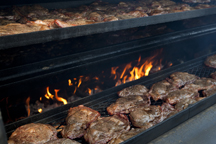
Photo Source: UF/IFAS Tyler Jones.
Summer brings on the craving to grill and that craving continues through the year! Millions of Americans will enjoy grilling as they gather with family and friends. Whether grilling outdoors or indoors, safe food handling is always important.
When shopping, pick up cold foods such as meat and poultry just before you checkout. Put these foods in plastic bags and keep separate from other foods in your cart. It is wise to have a cooler with ice in your car for all perishables but if not, plan to go directly home. Refrigerate or freeze meat and poultry promptly when you get home.
Thaw meat and poultry in the refrigerator and NEVER on the kitchen counter. For quicker thawing, thaw in the microwave and immediately place on the grill. Thaw meats, fish and poultry completely before grilling. If not thawed completely, the food will not cook evenly.
If marinating meats and poultry, do so in the refrigerator. USDA Food Safety and Inspection Service suggests that poultry and cubed meat may be marinated for up to 2 days and roasts, chops, and steaks marinated up to 5 days. If some of the marinade will be used as a sauce on the cooked food, reserve a portion before putting raw meat and poultry in it. However, if the marinade used on raw meat or poultry is to be reused, make sure to let it come to a boil first to destroy any harmful bacteria.
Use separate utensils, platters, and pans for raw and cooked meat and poultry. Raw juices are high in bacteria and could contaminate safely cooked food.
Never partially cook meat or poultry and save to continue cooking later on the grill. If you do pre-cook, cook these foods completely then cool, refrigerate and reheat later on the grill.
Cook meat such as steaks, roasts, and chops to 145°F. Ground meats such as beef, pork, veal and lamb cooked to 160°F. All poultry, whether whole, pieces or ground, should be cooked to 165°F. Fish and shellfish should be cooked to 145°F.
During the past few years, there have been a few concerns about grilled meats causing cancer.
Some research suggests there may be a cancer risk related to eating meat and poultry cooked by high-heat cooking techniques such as grilling, frying, and broiling. Current research suggest eating moderate amounts of grilled meats, fish, and poultry cooked to a safe temperature, without charring, does not pose a problem. Prevent charring by removing visible fat that can cause a flare-up. Meat can also be precooked immediately before placing on the grill, which helps to release some of the juices that can drop on coals.
So, keep on grilling, but keep your food safe!
Please click here to answer a few questions to help us better serve you.
by Marjorie Moore | Feb 11, 2015
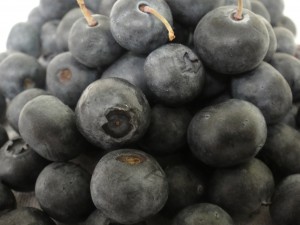
Photo taken by: Marjorie Moore
February is heart month, a time to consider including foods in your diet that will benefit your heart. Much has been in the media during the last few years about the positive heart health benefits of blueberries, red wine and dark chocolate. According to research, the compounds responsible for the positive effects are called flavonoids, which occur naturally in food.
Flavonoids that promote heart health fall into six major categories. One category is flavonols and those are found in small amounts in some fruits and vegetables. This is another good reason to consume these foods. An example of a good food source for flavonols is one cup of kale, which contains 62 milligrams of flavonols.
Another category, anthocyanindins, gives fruits and vegetables their red, blue or purple color and protects the body from free radicals. To get the most benefit from anthocyanindins, it is best to consume fruits and vegetables in their raw or fresh state. One cup of fresh cranberries contain 101 milligrams of anthocyanindins. Cranberry sauce has a much lower amount of anthocyanindins.
To learn more about flavonols and anthocyanindins and the remaining four flavonoids, click on this link http://edis.ifas.ufl.edu/pdffiles/FS/FS24400.pdf
Source: Facts about Flavonoids, EDIS Publication FSHN14-04
by Marjorie Moore | Nov 22, 2014
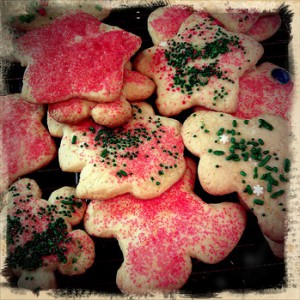 Eat, drink, be happy and be healthy this holiday season. My favorite holidays are just around the corner. It is an exciting time to be with family and friends. There is usually lots of food that may come with lots of calories and carbohydrates. Are you wondering how to survive this holiday season without adding more calories and carbohydrates to your diet?
Eat, drink, be happy and be healthy this holiday season. My favorite holidays are just around the corner. It is an exciting time to be with family and friends. There is usually lots of food that may come with lots of calories and carbohydrates. Are you wondering how to survive this holiday season without adding more calories and carbohydrates to your diet?
The first thing to keep in mind is to plan your meals to help keep your diabetes management on track. Persons with diabetes should space out their carbohydrate intake throughout the day. Fruits, starchy vegetables, dairy foods, and grain foods all contain carbohydrates. Eating the right amount of carbohydrates throughout the day will help you control your blood glucose levels. The Idaho Plate method of meal planning is one of many tools to help control carbohydrates while recommending at least one-half your plate consist of vegetables. More information on the Idaho Plate can be found at http://edis.ifas.ufl.edu/fy334 .
If you going to a party or eating at a friend or relative’s home and the meal time is around your normal dinner time, try to eat the same amount of carbohydrate that you normally would eat. You may ask your host if you can bring a covered dish. If so, take your favorite low carbohydrate dish to share.
Avoid or limit the amount of sugary drinks like soda, fruit punch or drinks, sweet tea and eggnog. These drinks raises blood glucose and can provide lots of calories in one serving. For example, one cup of fruit punch contains 100 calories or more and at least 30 grams of carbohydrate; and, one cup of eggnog may have as many as 344 calories and more than 34 grams of carbohydrates. A much better choice is to choose diet or other low-calorie drinks that are available in several flavors. Remember, water is a much healthier choice and has no calories.
Fill up on salad first. Filling up on salad or other raw veggies will fill you up without lots of calories.
Don’t forget to focus on conversation. Make an effort to meet new friends or circulate with those you know instead of eyeing the food.
Stay active this holiday season. Put yourself on your gift list by treating yourself to a personal trainer, fitness class series or membership to a gym.
Learn more about how you can enjoy eating healthy as a diabetic this holiday season by contacting your local UF/IFAS Extension Office .





